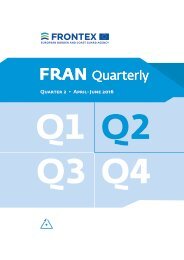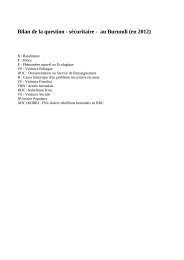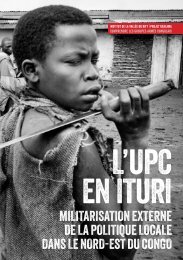You also want an ePaper? Increase the reach of your titles
YUMPU automatically turns print PDFs into web optimized ePapers that Google loves.
SOCIAL MEDIA<br />
CONCLUSION<br />
The two case studies examined in this piece demonstrate both the potential<br />
and perils of using social media to assess IS’s local support. IS social media<br />
propaganda cannot be relied upon in isolation; doing so is akin to relying on<br />
the Korean Central News Agency to understand developments in the Korean<br />
Peninsula. That is why I argue for analysis based on multiple metrics, incorporating<br />
evidentiary sources that indicate where social media alone can be<br />
misleading, as well as where it is revelatory.<br />
Social media is not going away, nor are efforts by analysts to use it as<br />
a filter for understanding militant groups. This article proposes metrics for<br />
doing so. Over time, the methods and metrics for social media–based analysis<br />
of local support for militant organizations such as IS will surely be further<br />
refined and improved.<br />
NOTES<br />
1. See Daveed Gartenstein-Ross and Nathaniel Barr, “Neither Remaining nor Expanding:<br />
The Islamic State’s Global Expansion Struggles,” War on the Rocks, February 23,<br />
2016, http://warontherocks.com/2016/02/neither-remaining-nor-expanding-theislamic-states-global-expansion-struggles/.<br />
2. See Daveed Gartenstein-Ross, Jason Fritz, Bridget Moreng, and Nathaniel Barr,<br />
Islamic State vs. al-Qaeda: Strategic Dimensions of a Patricidal Conflict (Washington<br />
DC: New America Foundation, 2015), pp. 4–5, describing al-Qaeda’s strategy as<br />
Maoist in orientation, while IS’s more resembles focoism.<br />
3. See Aaron Y. Zelin, The Islamic State’s Territorial Methodology, Research Note 29<br />
(Washington DC: Washington Institute, 2016), explaining that IS may advertise its<br />
dawa and hisba efforts in territories where it only has partial control.<br />
4. See Jacob Zenn, “A Biography of Boko Haram and the Baya to al-Baghdadi,” CTC<br />
Sentinel, March 19, 2015, https://www.ctc.usma.edu/posts/a-biography-of-bokoharam-and-the-baya-to-al-baghdadi.<br />
5. For discussion of Ansar al-Sharia Tunisia’s strategy by way of contrast to IS, see Daveed<br />
Gartenstein-Ross, Ansar al-Sharia Tunisia’s Long Game: Dawa, Hisba and Jihad<br />
(The Hague: ICCT—The Hague, 2013).<br />
6. World Bank, “Internet Users (Per 100 People),” http://data.worldbank.org/indicator/IT.NET.USER.P2.<br />
7. “Bayan Ansar al-Dawla al-Islamiyya fi Jazirat al-Arab,” YouTube video, posted by<br />
“Hafid Sayf Allah al-Maslul,” October 10, 2014.<br />
8. Abu Bakr al-Baghdadi, “Wa-law Kariha al-Kafirun,” al-Furqan Media, Nov. 13, 2014.<br />
9. Observation by BBC Monitoring, December 10, 2014.<br />
57






